Long Serpent: Most Famous Viking Longship Of King Olav Tryggvason Of Norway And Its Fate
A. Sutherland - AncientPages.com - The Vikings used wooden longships or dragonships with wide, shallow-draft hulls, allowing navigation in rough seas or in shallow river waters. Their ships could be landed on a beach, and their light weight enabled them to be hauled over land if necessary.
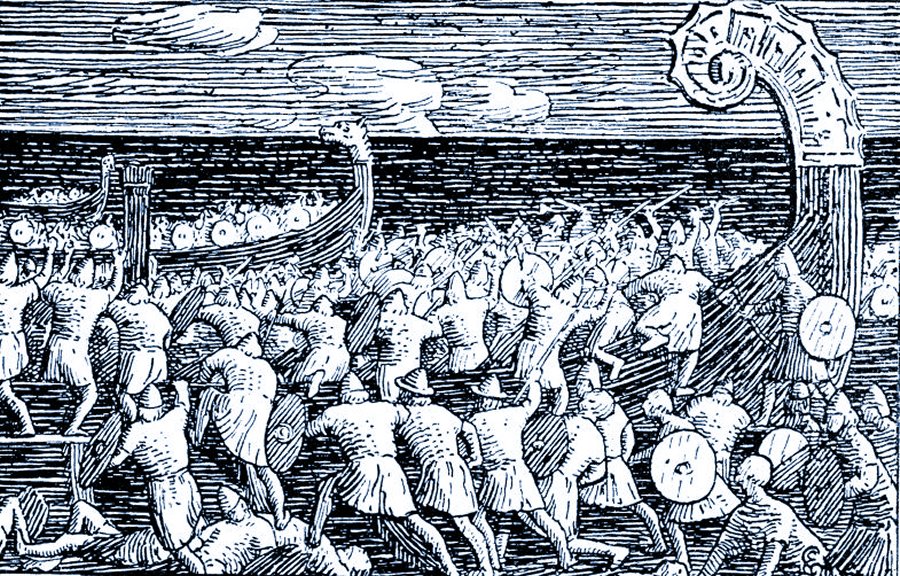 Saga of Olaf Tryggvason “Eiriks men board the Long Serpent in the battle of Svolder.” Ill. Halfdan Egedius
Saga of Olaf Tryggvason “Eiriks men board the Long Serpent in the battle of Svolder.” Ill. Halfdan Egedius
"Dragonships" with a dragon-shaped bow, symbolized the Viking times. They were the largest longships of the Vikings.
They were decorated with beautifully carved heads of dragons and other magical beings mounted on their stems. These solid ships were built for chieftains and kings and were most probably first developed in Northern Norway.
The Long Serpent ("Ormen Lange") was the most legendary warship and the pride of the Norwegian King Olav Tryggvason (995-1000). It was built on special orders of Tryggvason, who had captured a similar but smaller dragon ship. This one had to be far more extensive and more carefully put together.
A Viking longship. Image source
Thorberg Skafhog was the master builder of the ship, and he had many hard-working men who fell wood and shaped it while others made nails and carried timber.
Extraordinary qualities of "Long Serpent"
Snorri Sturluson wrote in "Heimskringla" that it was exceptionally long, built on the model Drakkar, and its stem and stern were gilded. The ship was long, broad, high-sided, and strongly timbered.
"The ship was a dragon...but this ship was far larger, and more carefully put together in all her parts…. The length of the keel that rested upon the grass was seventy-four ells. The Long Serpent had thirty-four benches for rowers. The head and the arched tail were both gilt, and the bulwarks were as high as in sea-going ships. This ship was the best and most costly ship ever made in Norway..."
The Battle of Svolder, at which the Jomsvikings fought with Denmark against Norway, maybe with a swap of allegiance to side with Forkbeard's advantage, of his 400 ships to Tryggvason's 100. Image credit: Otto Sinding - Painting by Otto Sinding - Public Domain
The Long Serpent was equipped with 34 sections for rovers, 68 half-sections, and 68 oars. "In every half-section were eight men, and each and all chosen men; and in the fore-hold were thirty men… and the ship had a crew of 574 men."
The "Long Serpent" was approximately 48m long or even longer. It was this ship, in which Olaf Tryggvason fought his last fight at Svolder (Svoldr).
In 1000 AD, the "Long Serpent" and King Olav Tryggvason participated in the famous sea battle at Svolder, (today, probably Rügen in Germany.)
 Olav Tryggvason is elected king of Norway. Painting by Peter Nicolai Arbo 1860. Public Domain
Olav Tryggvason is elected king of Norway. Painting by Peter Nicolai Arbo 1860. Public Domain
His fleet faced a coalition of three powerful rulers, Eric (Håkonsson) Haakonsson (960s – the 1020s), Governor of Norway and Earl of Northumbria, King Olaf of Sweden (ca.980 – 1022), and King Svein of Denmark (960 – 1014) who together combined their forces, which means they had 71 ships against Tryggvason's 11 warships.
They ambushed Tryggvason, and his ships were boarded and captured. The fiercest fighting took place on the "Long Serpent," the last boat to be captured by enemies.
"…The deck was wet with blood. More and more of Eirik's men climbed aboard and closed in the stern, hacking with broadaxes and swords. When Olav and his remaining men saw that the battle was lost, they leaped into the sea with their armor, shields, and weapons.
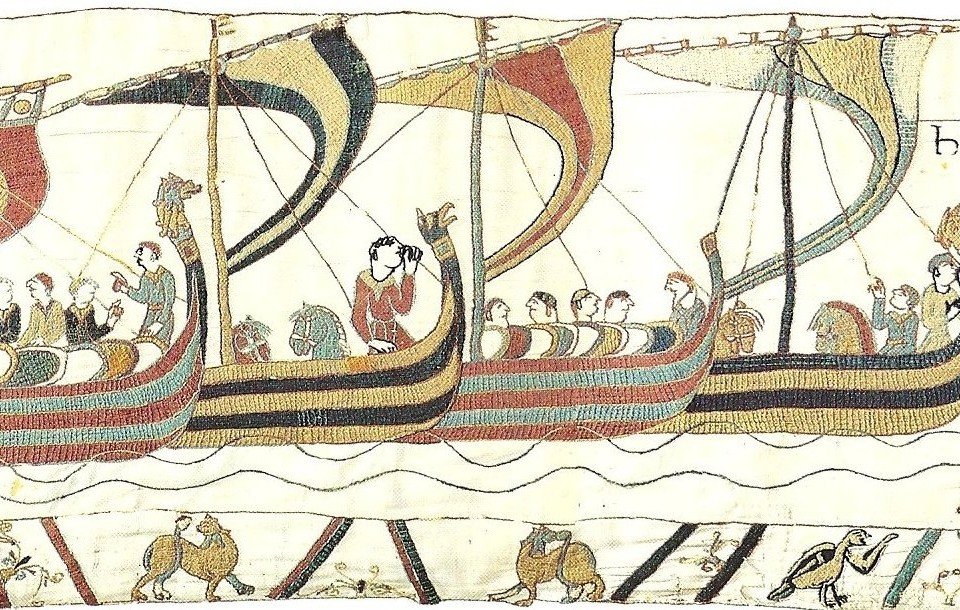 Viking longships on the Bayeux Tapestry
Viking longships on the Bayeux Tapestry
The enemy tried to seize the King before he sank. But he pulled his shield over his head and vanished beneath the waters..." wrote Robert Wernick in his book "The Vikings."
The magnificent "Long Serpent" became Eirik's booty and a share of Norway. Two hundred years later, in the 13th century, when Snorri Sturluson recorded "King Olaf's saga," the "Long Serpent's" oaken bones were still visible beside Trondheim Fjord, a reminder of the greatness of the Viking mariner and the boldness of the Viking warrior…."
The "Long Serpent" was neither the fastest nor the best rowing ship in Tryggvason's fleet; still, there was something special about it.
The ship became legendary for its size and extraordinary qualities when it was used and later in the sagas about Olav Tryggvason.
It is still remembered today.
Written by – A. Sutherland AncientPages.com Staff Writer
Updated on December 10, 2022
Copyright © AncientPages.com All rights reserved. This material may not be published, broadcast, rewritten or redistributed in whole or part without the express written permission of AncientPages.com
Expand for referencesReferences:
Björn Landström, The Ship
Stephen K. Stein, The Sea in World History
Kosiarz E., Wojny na Bałtyku X-XIX wieku
Wernick R. The Vikings
More From Ancient Pages
-
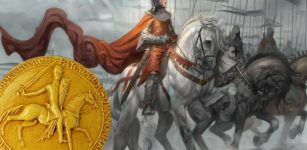 Richard The Lionheart: Famous Leader, Warrior And Military Mastermind But Not The Best English King
Featured Stories | May 29, 2017
Richard The Lionheart: Famous Leader, Warrior And Military Mastermind But Not The Best English King
Featured Stories | May 29, 2017 -
 Idol Of Pachacamac Inca God Reveals Its Colors
Archaeology | Jan 21, 2020
Idol Of Pachacamac Inca God Reveals Its Colors
Archaeology | Jan 21, 2020 -
 What Is The History Of Pancakes?
Ancient History Facts | Mar 7, 2024
What Is The History Of Pancakes?
Ancient History Facts | Mar 7, 2024 -
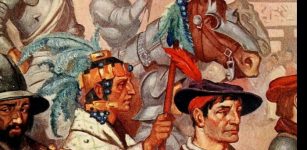 On This Day In History: Spanish Conquistadors Led By Hernan Cortés Entered The Aztecs Capital Tenochtitlán – On Nov 8, 1519
News | Nov 8, 2016
On This Day In History: Spanish Conquistadors Led By Hernan Cortés Entered The Aztecs Capital Tenochtitlán – On Nov 8, 1519
News | Nov 8, 2016 -
 Mysterious Time Slips Near An Ancient Church – Reported
Featured Stories | Oct 23, 2018
Mysterious Time Slips Near An Ancient Church – Reported
Featured Stories | Oct 23, 2018 -
 Ancient Tomb Of ‘Bird Oracle Markos’ Unearthed In Bergama (Pergamon), Turkey
Archaeology | Sep 6, 2022
Ancient Tomb Of ‘Bird Oracle Markos’ Unearthed In Bergama (Pergamon), Turkey
Archaeology | Sep 6, 2022 -
 Something Strange Happened To Our Ancestors 900,000 Years Ago – Genetic Study Reveals
DNA | Sep 1, 2023
Something Strange Happened To Our Ancestors 900,000 Years Ago – Genetic Study Reveals
DNA | Sep 1, 2023 -
 On This Day In History: Terrorist Attacks On World Trade Center And Pentagon – On Sep 11, 2001
News | Sep 11, 2016
On This Day In History: Terrorist Attacks On World Trade Center And Pentagon – On Sep 11, 2001
News | Sep 11, 2016 -
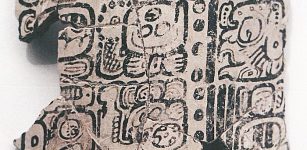 Painted Komkom Vase With Longest Hieroglyphic Text Unearthed In Belize
Archaeology | Apr 24, 2019
Painted Komkom Vase With Longest Hieroglyphic Text Unearthed In Belize
Archaeology | Apr 24, 2019 -
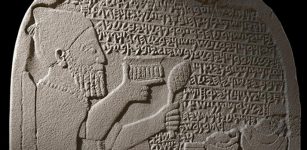 Ancient Kuttamuwa Stele And Iron Age Belief That Soul Lived In Funerary Slab
Featured Stories | Sep 10, 2016
Ancient Kuttamuwa Stele And Iron Age Belief That Soul Lived In Funerary Slab
Featured Stories | Sep 10, 2016 -
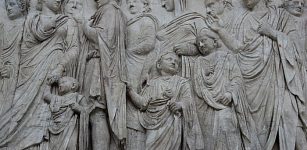 Ara Pacis: Altar In Rome Dedicated To Pax, The Roman Goddess Of Peace
Ancient History Facts | Apr 4, 2016
Ara Pacis: Altar In Rome Dedicated To Pax, The Roman Goddess Of Peace
Ancient History Facts | Apr 4, 2016 -
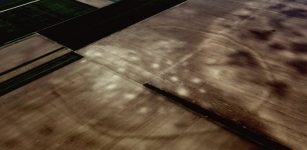 Vast Network Of Previously Unknown European Bronze Age Megastructures Discovered
Archaeology | Nov 20, 2023
Vast Network Of Previously Unknown European Bronze Age Megastructures Discovered
Archaeology | Nov 20, 2023 -
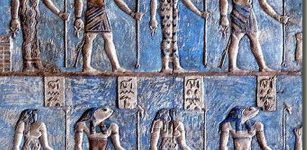 Number Eight Powerful Symbol In Ancient Traditions Of Many Cultures
Ancient Symbols | Dec 8, 2017
Number Eight Powerful Symbol In Ancient Traditions Of Many Cultures
Ancient Symbols | Dec 8, 2017 -
 Astrape And Bronte – Twin Goddesses Of Lightning And Thunder Carried God Zeus’ Thunderbolts
Featured Stories | Jan 22, 2019
Astrape And Bronte – Twin Goddesses Of Lightning And Thunder Carried God Zeus’ Thunderbolts
Featured Stories | Jan 22, 2019 -
 Unique 2,000-Year-Old Decorated Roman Sandal Lost By Well-Cleaner Found In Spain
Archaeology | Oct 19, 2023
Unique 2,000-Year-Old Decorated Roman Sandal Lost By Well-Cleaner Found In Spain
Archaeology | Oct 19, 2023 -
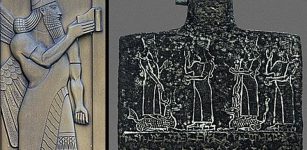 Mesopotamian God Nabu Inscribed The Human Fates Determined By The Gods
Featured Stories | Aug 7, 2018
Mesopotamian God Nabu Inscribed The Human Fates Determined By The Gods
Featured Stories | Aug 7, 2018 -
 Mysterious Books With Dangerous Secret Knowledge Deliberately Hidden From Public View
Featured Stories | Jan 8, 2024
Mysterious Books With Dangerous Secret Knowledge Deliberately Hidden From Public View
Featured Stories | Jan 8, 2024 -
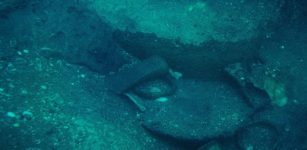 Ancient Copper Ingots Are Unlocking Iron Age Secrets
Archaeology | Dec 13, 2021
Ancient Copper Ingots Are Unlocking Iron Age Secrets
Archaeology | Dec 13, 2021 -
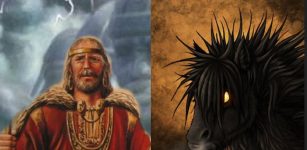 Pooka: Solitary Spirit And Not Entirely Benevolent Prankster In Irish Folklore
Celtic Mythology | Jun 4, 2016
Pooka: Solitary Spirit And Not Entirely Benevolent Prankster In Irish Folklore
Celtic Mythology | Jun 4, 2016 -
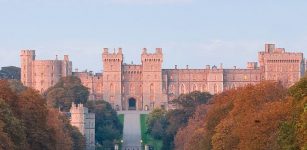 Where Does The Expression ‘Saved By A Bell’ Come From?
Ancient History Facts | Oct 16, 2019
Where Does The Expression ‘Saved By A Bell’ Come From?
Ancient History Facts | Oct 16, 2019


